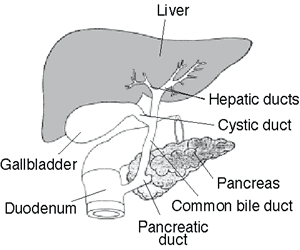biliary system

The gallbladder and the ducts that carry bile and other digestive enzymes from the liver, gallbladder, and pancreas to the small intestine are called the biliary system.
The biliary system consists of the organs and ducts by which bile is formed, concentrated, and carried from the liver to the duodenum (the first part of the small intestine). Bile removes waste products from the liver and carries bile salts, necessary for the breakdown and absorption of fat, to the intestine.
Bile is secreted by the liver cells and collected by a system of tubes that mirrors the blood supply to the organ. This network of bile-drainage channels carries the bile out of the liver by way of the hepatic ducts, which join together to form a common duct that opens into the duodenum at a controlled orifice called the ampulla of Vater. Bile does not pass directly into the duodenum but is first concentrated and then stored until needed in the gall bladder, a pear-shaped reservoir lying in a hollow under the liver, to which it gains access by way of the cystic duct.
When food is eaten, the presence of fat in the duodenum causes the secretion of a hormone, which opens the ampulla of Vater and causes the gall bladder to contract, squeezing stored bile via the cystic and common bile ducts into the duodenum. In the duodenum, bile salts emulsify the fat, breaking it down to a kind of milk of microscopic globules.


